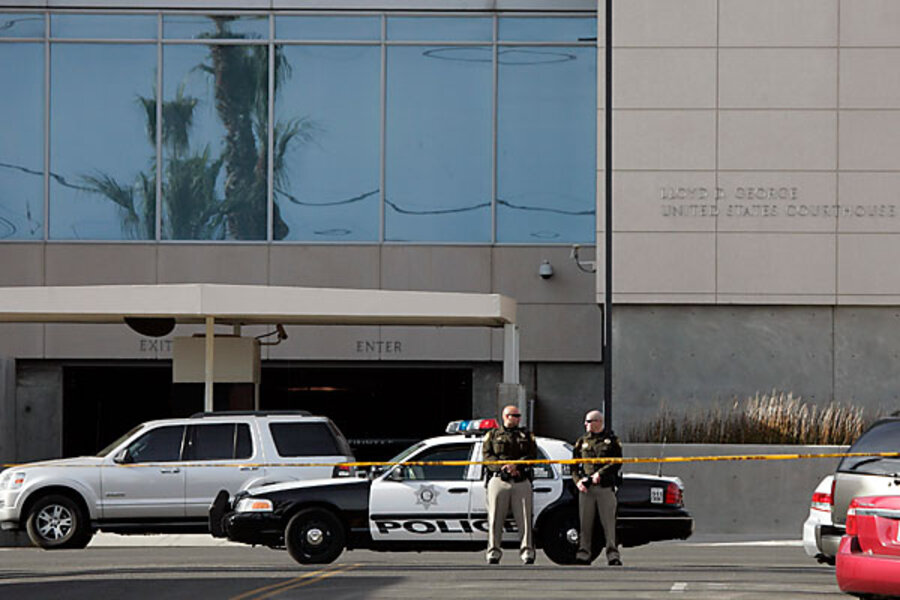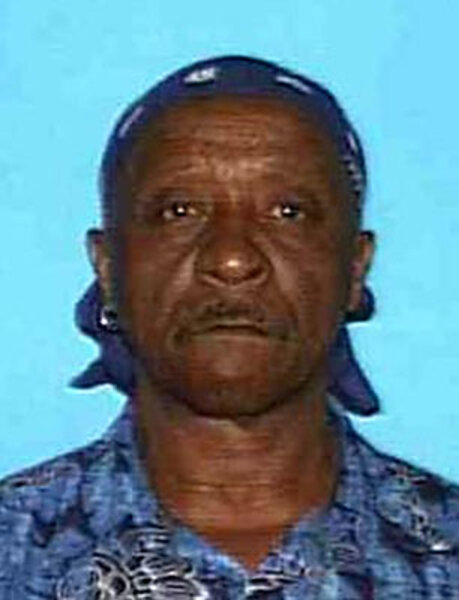Las Vegas shooting: rage against the courts
Loading...
The deadly shooting at a Las Vegas federal courthouse Monday highlights the type of threat to courthouse security that's hardest to protect against – targeted attacks on courts and judges by jilted plaintiffs
On Monday, Johnny Lee Wicks walked into the lobby of the Lloyd George US Courthouse and Federal Building, about a mile from the Las Vegas Strip, and apparently opened fire with a shotgun that was hidden under his jacket. He killed a security officer and wounded a US marshal. Mr. Wicks was killed in the shootout that followed.
Early reports indicate that Wicks was upset over a judge’s Feb. 9 dismissal of his lawsuit against the Social Security Administration. The suit claimed that his benefits were cut because he was black. In his court filings, he claimed to be the victim of a government scam perpetrated against “old blacks who are not well educated.”
Federal officials are still investigating the shooting and the motive, but all indications point to a man lashing out at the legal system over a sense of being wronged by the federal government.
“Our investigation strongly indicates that Wicks acted alone and that his motive was an overwhelming anger toward the United States government,” said FBI special agent Kevin Favreau at a Tuesday press conference, according to the Las Vegas Sun.
Newer federal courthouses such as the one in Las Vegas are designed to enhance security, but the sort of threat posed by Wicks and others is not easy to defend against. While threats against judges are on the rise, law enforcement officers say it's often difficult to distinguish which threats could lead to violence. Also, according a December report by the US Justice Department's Office of the Inspector General, many threats to judges and other court officers go unreported.
It’s unknown if Wicks, who had a lengthy criminal record that included sexual assault and murder charges, made any threats to federal the federal judge in Las Vegas who dismissed his case prior to Monday's shooting, or would have given federal agents any reason to suspect he was capable of such violence.
Threat assessment is "the part that we have to work a lot harder on, but it also takes a lot more resources, time, and funding,” says Lt. Jimmie Barrett, a court security supervisor in Arlington, Va., and author of “Protecting Court: A Practitioner’s Guide to Court Security.”
Most efforts to prevent targeted violence toward courts has "focused on enhancing physical security measures in courthouse," wrote a group of experts in a 2001 article for the US Secret Service’s National Threat Assessment Center. "However, a critical, but often neglected, component of efforts to prevent planned attacks is the development of a protective intelligence capacity, also referred to as threat assessment.”
Threat assessment in courthouse security took on new urgency in 2005 after US District Judge Joan Lefkow’s husband and mother were murdered by a man disgruntled over Judge Lefkow’s dismissal of his medical malpractice case.
In another high-profile incident, a Georgia judge, court reporter, and sheriff’s deputy were killed in 2005 by a man facing a rape conviction. In 1992, George Lott killed an assistant district attorney and lawyer because he was upset over his divorce.
The recent Justice Department report found that threats to federal judges and other court personnel have more than doubled over the past six years. In many instances, said the inspector general, the US Marshals Service did not consistently address the threats.
In the case of the Las Vegas shooting, the security at the courthouse worked, says Lieutenant Barrett, to the extent that it prevented the gunman from getting past the metal detectors and keeping others in the courthouse safe.
But, he adds, “There is a point where you are not going to be able to prevent everything."
---
Follow us on Twitter.






